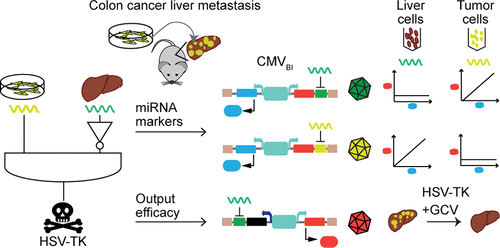当前位置:
X-MOL 学术
›
ACS Synth. Biol.
›
论文详情
Our official English website, www.x-mol.net, welcomes your
feedback! (Note: you will need to create a separate account there.)
A Workflow for In Vivo Evaluation of Candidate Inputs and Outputs for Cell Classifier Gene Circuits
ACS Synthetic Biology ( IF 3.7 ) Pub Date : 2017-12-19 00:00:00 , DOI: 10.1021/acssynbio.7b00303 Margaux Dastor 1 , Joerg Schreiber 1 , Laura Prochazka 1 , Bartolomeo Angelici 1 , Jonathan Kleinert 1 , Ina Klebba 1 , Jiten Doshi 1 , Linling Shen 1 , Yaakov Benenson 1
ACS Synthetic Biology ( IF 3.7 ) Pub Date : 2017-12-19 00:00:00 , DOI: 10.1021/acssynbio.7b00303 Margaux Dastor 1 , Joerg Schreiber 1 , Laura Prochazka 1 , Bartolomeo Angelici 1 , Jonathan Kleinert 1 , Ina Klebba 1 , Jiten Doshi 1 , Linling Shen 1 , Yaakov Benenson 1
Affiliation

|
Cell classifier gene circuits that integrate multiple molecular inputs to restrict the expression of therapeutic outputs to cancer cells have the potential to result in efficacious and safe cancer therapies. Preclinical translation of the hitherto developments requires creating the conditions where the animal model, the delivery platform, in vivo expression levels of the inputs, and the efficacy of the output, all come together to enable detailed evaluation of the fully assembled circuits. Here we show an integrated workflow that addresses these issues and builds the framework for preclinical classifier studies using the design framework of microRNA (miRNA, miR)-based classifier gene circuits. Specifically, we employ HCT-116 colorectal cancer cell xenograft in an experimental mouse metastatic liver tumor model together with Adeno-associated virus (AAV) vector delivery platform. Novel engineered AAV-based constructs are used to validate in vivo the candidate inputs miR-122 and miR-7 and, separately, the cytotoxic output HSV-TK/ganciclovir. We show that while the data are largely consistent with expectations, crucial insights are gained that could not have been obtained in vitro. The results highlight the importance of detailed stepwise interrogation of the experimental parameters as a necessary step toward clinical translation of synthetic gene circuits.
中文翻译:

体内评估细胞分类器基因电路候选输入和输出的工作流程
整合多个分子输入以限制治疗性输出表达给癌细胞的细胞分类器基因电路有可能导致有效且安全的癌症治疗。迄今为止开发的临床前翻译需要创造条件,使动物模型,递送平台,体内输入的表达水平和输出的效率都集中在一起,可以对完整组装的电路进行详细评估。在这里,我们展示了一个集成的工作流程,该流程解决了这些问题,并使用基于microRNA(miRNA,miR)的分类器基因电路的设计框架为临床前分类器研究构建了框架。具体来说,我们将HCT-116结直肠癌细胞异种移植物与腺相关病毒(AAV)载体递送平台一起用于实验性小鼠转移性肝肿瘤模型中。基于AAV的新型工程化构建体用于体内验证候选药物分别输入miR-122和miR-7,以及细胞毒性输出HSV-TK /更昔洛韦。我们表明,尽管数据与预期基本一致,但获得了关键的见解,而这些见解是无法在体外获得的。结果突出了逐步详细询问实验参数的重要性,这是迈向合成基因电路临床翻译的必要步骤。
更新日期:2017-12-19
中文翻译:

体内评估细胞分类器基因电路候选输入和输出的工作流程
整合多个分子输入以限制治疗性输出表达给癌细胞的细胞分类器基因电路有可能导致有效且安全的癌症治疗。迄今为止开发的临床前翻译需要创造条件,使动物模型,递送平台,体内输入的表达水平和输出的效率都集中在一起,可以对完整组装的电路进行详细评估。在这里,我们展示了一个集成的工作流程,该流程解决了这些问题,并使用基于microRNA(miRNA,miR)的分类器基因电路的设计框架为临床前分类器研究构建了框架。具体来说,我们将HCT-116结直肠癌细胞异种移植物与腺相关病毒(AAV)载体递送平台一起用于实验性小鼠转移性肝肿瘤模型中。基于AAV的新型工程化构建体用于体内验证候选药物分别输入miR-122和miR-7,以及细胞毒性输出HSV-TK /更昔洛韦。我们表明,尽管数据与预期基本一致,但获得了关键的见解,而这些见解是无法在体外获得的。结果突出了逐步详细询问实验参数的重要性,这是迈向合成基因电路临床翻译的必要步骤。











































 京公网安备 11010802027423号
京公网安备 11010802027423号